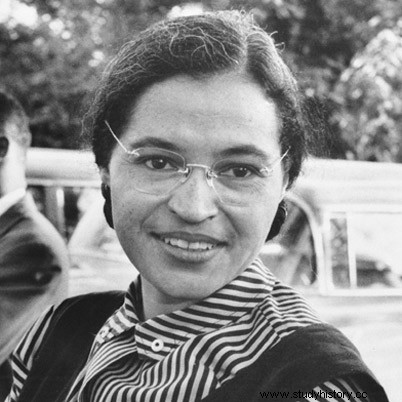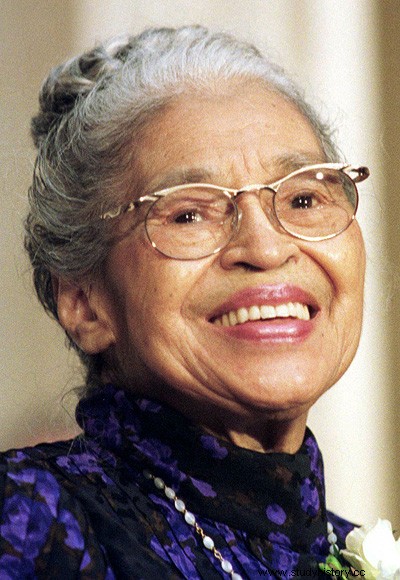Icon of the civil rights movement, Rosa Parks (1913 – 2005) distinguished herself by refusing her seat to a white man on a bus. Beyond this action, she was heavily involved in the civil rights movement.
A childhood marked by racism and segregation
 Daughter of Leona and James McCauley, respectively a teacher and a carpenter, Rosa Louise was born on February 4, 1913 in Alabama. In her youth, she had chronic health problems. After her parents' divorce, she lives with her mother, brother and grandparents. Until she was 11, it was Leona who took charge of her education, to which she attached great importance, then Rosa studied in schools for black children. But her school was burned down twice by members of the Klu Klux Klan, and she had to interrupt her studies before the end, to take care of her sick grandmother and then her mother.
Daughter of Leona and James McCauley, respectively a teacher and a carpenter, Rosa Louise was born on February 4, 1913 in Alabama. In her youth, she had chronic health problems. After her parents' divorce, she lives with her mother, brother and grandparents. Until she was 11, it was Leona who took charge of her education, to which she attached great importance, then Rosa studied in schools for black children. But her school was burned down twice by members of the Klu Klux Klan, and she had to interrupt her studies before the end, to take care of her sick grandmother and then her mother.
Rosa faces racism on a daily basis. His grandfather, worried by the actions of the KKK, stands guard in front of the family farm. It is marked by the fountains reserved for whites or blacks, by the prohibition of school transport for yellow or black children and by the sections reserved in the buses. It was there, she says, that she realized “there [is] a world for black people and a world for white people.”
Rosa and the NAACP
In 1930 Rosa began working as a seamstress; she is also a caregiver. In 1932, she married Raymond Parks, an Alabama member of the Association for the Advancement of Colored People (National Association for the Advancement of Colored People). , NAACP). Both are involved in various civil rights movements.
Rosa is particularly involved against sexual violence inflicted on black women. In 1944, she organized the defense of Recy Taylor, a young black woman kidnapped and raped by six white men. The first trial resulted in no convictions and Recy endured death threats and attacks on his home for months. Rosa is working to spread her story and create a national movement demanding justice for the young woman. It brings together great figures of the civil rights movement such as W.E.B. Du Bois and Mary Church Terrell, but the second trial also did not result in a conviction. Recy Taylor won't get justice.
Refusal to give way
In 1955, Claudette Colvin, a 15-year-old NAACP member, was arrested and handcuffed for refusing to give up her seat to a white man; Rosa Parks raises funds to defend her. But Claudette is pregnant and the NAACP judges that this fact will be reproached to her and could harm the cause. Another woman, Mary Louise Smith, is also not defended because of her alcoholic father. On November 27, 1955, after the savage murder of Emmett Till which shocked many African Americans, Rosa attended a large meeting on the murder, held by T.R.M. Howard, civil rights activist. On December 1, 1955, a bus driver, James Blake, ordered him to give up his seat to a white man and to sit at the back; Rosa refuses.
The Montgomery Bus Boycott
 Rosa Parks is arrested, tried, and charged with public disorder and violation of local laws. His case immediately turns into a challenge to the segregation law. Quickly, 50 leaders of the African-American community, led by Martin Luther King, meet to discuss the actions to be taken following the arrest of Rosa Parks. They found the Montgomery Improvement Association and elect Luther King president. A Montgomery bus boycott is organized; it will last 381 days. Violence and vexations are perpetrated against blacks. Finally, on November 13, 1956, the United States Supreme Court ruled that bus segregation was unconstitutional. The boycott ends on November 20, but the violence does not end.
Rosa Parks is arrested, tried, and charged with public disorder and violation of local laws. His case immediately turns into a challenge to the segregation law. Quickly, 50 leaders of the African-American community, led by Martin Luther King, meet to discuss the actions to be taken following the arrest of Rosa Parks. They found the Montgomery Improvement Association and elect Luther King president. A Montgomery bus boycott is organized; it will last 381 days. Violence and vexations are perpetrated against blacks. Finally, on November 13, 1956, the United States Supreme Court ruled that bus segregation was unconstitutional. The boycott ends on November 20, but the violence does not end.
Subsequently, Rosa Parks became an icon for the civil rights movement. From 1965 to 1988 (when she retired), she worked on the team of Democratic Representative from Michigan, African-American John Conyers in the United States House of Representatives.
Rosa Parks died on October 24, 2005 in Detroit.
